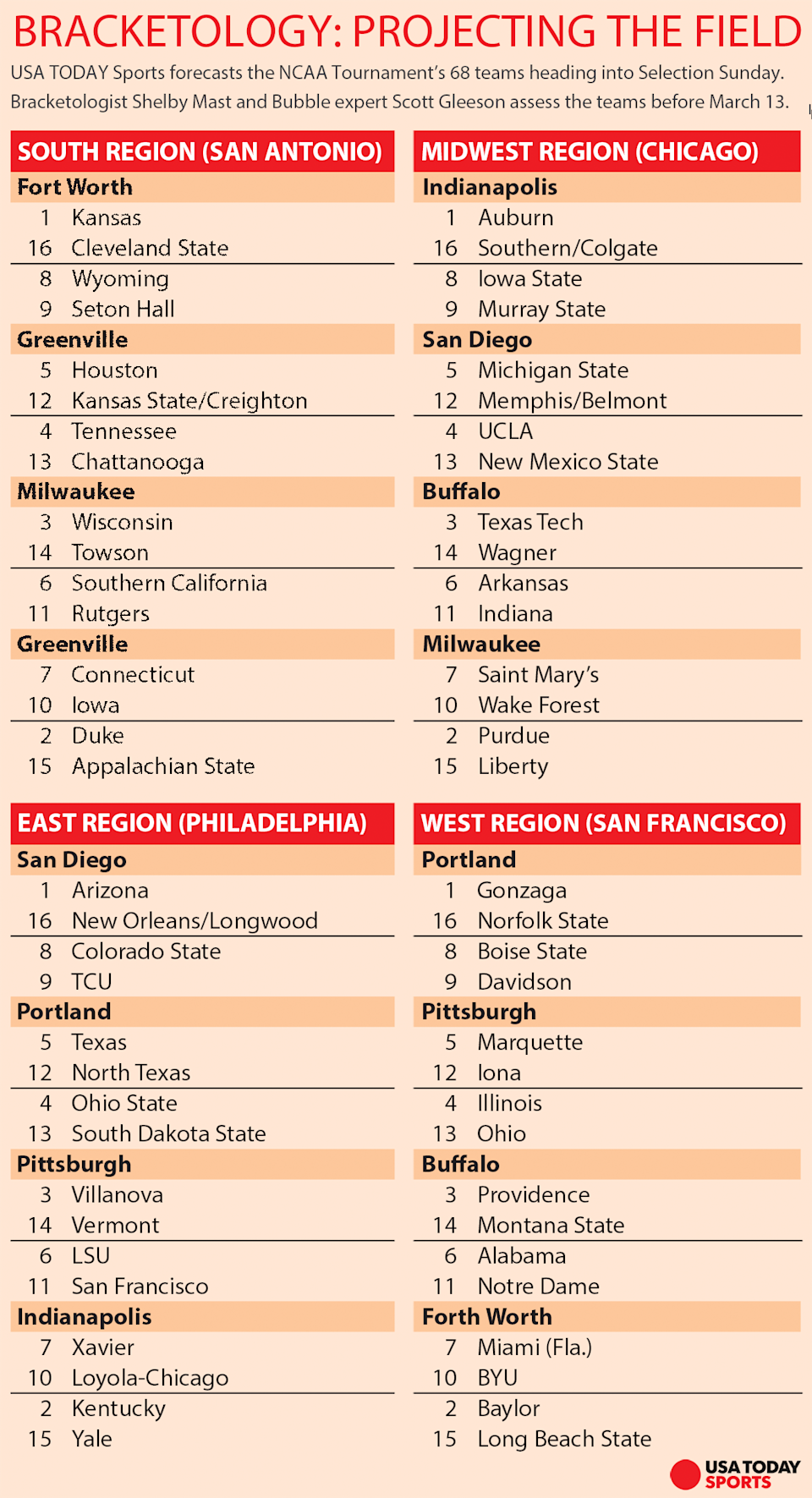The Big Ten has emerged as the conference with the most depth, meaning the league is well positioned to win the NCAA Tournament bubble come Selection Sunday.
Although the Big 12 has more teams near the top of the projected bracket and owns the country’s No. 1 NET rating, the Big Ten is currently forecasted to send the most teams – eight – dancing in March Madness. That’s largely a product of the depth across the board in this 14-team league.
In two weeks, Rutgers has vaulted into the projected field of 68 after being nowhere near the outside of the bubble prior to that stretch. That’s thanks to four consecutive Quadrant 1 victories – Michigan State, Ohio State, at Wisconsin and then Illinois on Wednesday. So many bubble teams won’t acquire four Q1 wins on their entire profiles. It’s evidence that the Big Ten has more opportunity to bulk up the résumé, and at the same time, the credentials of borderline teams can win out over others.
SPORTS NEWSLETTER: Sign up now for updates delivered to your inbox
MEN’S BASKETBALL COACHES POLL: Gonzaga still leads, Auburn keeps No. 2


While the committee pays no attention to conferences when selecting at-large bids, if it were to conduct a blind résumé test, all three of the Big Ten’s bubble teams – Rutgers, Indiana and Iowa – are beating out teams such as North Carolina (ACC) and Oklahoma (Big 12). Even Michigan, a team listed as the “next four out” on the latest bracket, owns a Q1 win over Purdue and sports a NET score in the 30s. That means if the Wolverines can slap together some late February wins, similar to Rutgers, then the Big Ten may even see nine teams in the NCAAs.
No. 1 seeds
Auburn, Gonzaga, Kansas, Arizona.
Last four in
Belmont, Creighton, Memphis, Kansas State.
First four out
SMU, North Carolina, Oklahoma, West Virginia.
Next four out
San Diego State, Virginia Tech, Michigan, Virginia.
***


***
Others considered for at-large bids: Cincinnati, Saint Bonaventure, Santa Clara, St. Johns, Colorado, Oregon, Washington State, Saint Louis, Stanford, Dayton, Florida, UAB, Mississippi State, VCU.
On life support: Drake, Vanderbilt, Louisiana Tech, Richmond, UCF, Missouri State, South Carolina, Texas A&M, Florida State, Minnesota, Fresno State, Toledo.
Multi-bid conferences: Big Ten (8), Big East (7), Big 12 (7), SEC (6), ACC (4), West Coast (4), Mountain West (3), Pac-12 (3), American Athletic (2), Ohio Valley (2).
Leaders or highest NET from projected one-bid conferences – (22 total): A10 – Davidson; America East – Vermont; Atlantic Sun – Liberty; Big Sky – Montana State; Big South – Longwood; Big West – Long Beach State; CAA – Towson; C-USA – UAB; Horizon – Cleveland State; Ivy League – Yale; MAAC – Iona; MAC – Ohio; MEAC – Norfolk State; Missouri Valley – Loyola-Chicago; Northeast – Wagner; Patriot – Colgate; Southern – Chattanooga; Southland – New Orleans; SWAC – Southern; Summit – South Dakota State; Sun Belt – Appalachian State; WAC – New Mexico State.
-
Ineligible schools: Oklahoma State (banned), Cal Baptist, North Alabama, Merrimack, Dixie State, Tarleton State, Bellarmine, UC San Diego, St. Thomas.
***
NCAA Tournament language explainer:
-
NET stands for the NCAA Evaluation Tool, which is the barometer for the selection committee. It includes game results, strength of schedule, game location, scoring margin (capping at 10 points per game), and net offensive and defensive efficiency.
-
Quadrant 1 wins: Home games vs. 1-30 NET teams; Neutral-site games vs. 1-50 NET; Away games vs. 1-75 NET
-
Quadrant 2 wins: Home games vs. 31-75 NET; Neutral-site games vs. 51-100 NET; Away games vs. 76-135 NET
-
Quadrant 3 wins: Home games vs. 76-160 NET; Neutral-site games vs. 101-200 NET; Away games vs. 136-240 NET
-
Quadrant 4 wins: Home games vs. 161-plus NET; Neutral-site games vs. 201-plus NET; Away games vs. 241-plus NET
Note: Most statistical data is used from WarrenNolan.com. The NET rankings (NCAA Evaluation Tool) also are a reference point.
About our bracketologist: Shelby Mast has been projecting the field since 2005 on his website, Bracket W.A.G. He joined USA TODAY in 2014. In his ninth season as our national bracketologist, Mast has finished as one of the top three bracketologists in the past eight March Madnesses. He’s also predicted for The Indianapolis Star, collegeinsider.com and is an inaugural member of the Super 10 Selection Committee. Follow him on Twitter @BracketWag.
About our college basketball reporter: Scott Gleeson has covered men’s college basketball for USA TODAY since 2012, contributing to bracketology and running Bubble Tracker before tackling everything March Madness following Selection Sunday. He correctly forecasted Virginia would win the national championship in 2019 before the season began and also picked Loyola-Chicago as a Cinderella mid-major in 2018. Follow him on Twitter @ScottMGleeson.
This article originally appeared on USA TODAY: NCAA Tournament bracketology: Big Ten’s depth can help it win bubble
